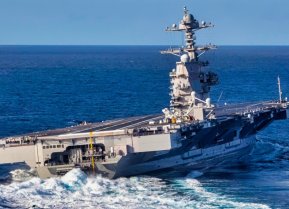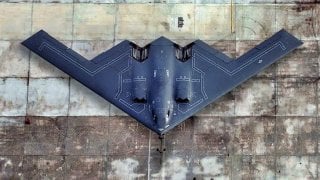B-2: The Most Expensive Military Plane Ever Is Now Even Most Costly
The United States Air Force has extended a substantial contract to Northrop Grumman, valued at approximately $7 billion, to provide modernization and sustainment support for the B-2 Spirit stealth bomber through 2029. It could be one of the last contracts for the B-2 as it reaches the end of its operational career.
Summary: The United States Air Force has extended a substantial contract to Northrop Grumman, valued at approximately $7 billion, to provide modernization and sustainment support for the B-2 Spirit stealth bomber through 2029. It could be one of the last contracts for the B-2 as it reaches the end of its operational career.
-This investment underscores the continuing commitment to maintain the operational readiness of the B-2 fleet until its anticipated replacement by the B-21 Raider in the early 2030s. The contract covers a range of services including software maintenance, engineering, and depot maintenance, crucial for preserving the B-2's stealth capabilities and combat readiness.
-The B-2, known for its pioneering "flying wing" design and stealth technology, remains a key component of the U.S. strategic bomber force, though it has been one of the most expensive planes in military history due to its advanced technology and reduced production numbers post-Cold War.
U.S. Air Force Invests $7 Billion in B-2 Spirit's Future Ahead of B-21 Raider Transition
The final price tag for the United States Air Force's Northrop Grumman B-2 Spirit bomber fleet could increase by another $7 billion after the aerospace giant was awarded a potential five-year contract to provide modernization and sustainment support for the stealth bomber.
Last Thursday, the Department of Defense announced the sole-source, indefinite-delivery/indefinite-quantity contract for the B-2 Spirit, and it includes software maintenance, engineering, programmed depot maintenance, support equipment, and other interim contractor services, according to a report from GovConWire.com.
Northrop Grumman will perform the work on the B-2 aircraft at its facility in Palmdale, California – while Whiteman Air Force Base (AFB), Missouri; Tinker AFB, Oklahoma; Wright Patterson AFB, Ohio; Edwards AFB, California; and Hill AFB, Utah will provide additional support, per Air & Space Forces magazine.
The contract will run through May 3, 2029.
The modernization and sustainment program will ensure the dual-capable B-2 Spirit can remain in the sky at least until the early 2030s – when it will be replaced with the Northrop Grumman B-21 Raider. There has been speculation that this could be one of the final contracts awarded to support the iconic stealth bomber.
"In partnership with the Air Force, Northrop Grumman is ensuring the B-2 Spirit fleet remains viable and mission-ready. The $7 billion Flexible Acquisition Sustainment Team III contract award is a reflection of our commitment to strengthening the B-2's sustainment as we continue to modernize the aircraft to meet the needs of the U.S. Air Force," said Jerry McBrearty, Northrop Grumman director and acting B-2 program manager, via a statement.
Costly B-2 Bomber
The B-2 was already the most expensive military plane ever built.
As reported by Breaking Defense, the potential $7 billion award issued last Thursday could work out to roughly $350 million in sustainment and modernization per B-2 Spirit aircraft – adding to the more than $2 billion that has been spent on each of the bombers to date.
Successful Flying Wing
The B-2 was the first successful "flying wing" aircraft to enter service – and it has proven to be quite the capable bomber. Its low-observable, or "stealth," characteristics have provided it the unique ability to penetrate an enemy's most sophisticated defenses and threaten its most valued, and heavily defended, targets. The Spirit's capability to penetrate air defenses and threaten effective retaliation further has provided a strong, effective deterrent and combat force well into the 21st century.
The B-2's low observability was derived from a combination of reduced infrared, acoustic, electromagnetic, visual, and radar signatures. Those features make it difficult for the sophisticated defensive systems to detect, track, and engage the B-2. Many aspects of the low-observability process remain classified; however, the B-2's composite materials, special coatings, and flying-wing design all further contribute to its "stealthiness."
The first Spirit rolled out of the bomber's final assembly facility in Palmdale, Calif., in November 1988 and it flew for the first time on July 17, 1989. Originally, the U.S. Air Force had plans for 132 B-2 Spirits, but as the aircraft was a product of the Cold War, it was originally designed to penetrate Soviet air defenses.
Following the dissolution of the Soviet Union, Congress slashed the budget for the Spirit, which cut production to just 21 aircraft. However, that ballooned the cost of each aircraft, as the R&D costs were spread over far fewer units, resulting in the $1.4 billion price tag.
And that's before the ongoing sustainment costs.
Author Experience and Expertise: Peter Suciu
Peter Suciu is a Michigan-based writer. He has contributed to more than four dozen magazines, newspapers, and websites with over 3,200 published pieces over a twenty-year career in journalism. He regularly writes about military hardware, firearms history, cybersecurity, politics, and international affairs. Peter is also a Contributing Writer for Forbes and Clearance Jobs. You can follow him on Twitter: @PeterSuciu. You can email the author: [email protected].


